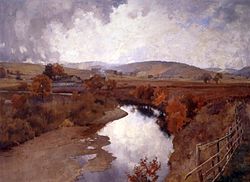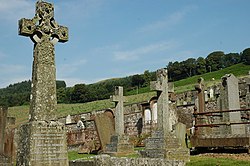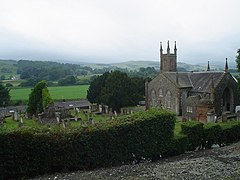Glencairn: Difference between revisions
Created page with "{{Infobox town |county=Dumfriesshire |latitude=55.193691 |longitude=-3.871822 |LG district= Dumfries and Galloway |post town= Thornhill |postcode = DG3 |dialling code= 01848 |..." |
No edit summary |
||
| Line 11: | Line 11: | ||
|picture caption=''"Autumn in Glencairn, Moniaive"'' (1887) by James Paterson | |picture caption=''"Autumn in Glencairn, Moniaive"'' (1887) by James Paterson | ||
}} | }} | ||
'''Glencairn''' is a parish in western [[Dumfriesshire]] adjacent to the border with [[Kirkcudbrightshire]]. It extends to over 30,000 acres. The parish includes the | '''Glencairn''' is a parish in western [[Dumfriesshire]] adjacent to the border with [[Kirkcudbrightshire]]. It extends to over 30,000 acres. The parish includes the villages of Kirkland and [[Moniaive]], and lies eight miles south-west of [[Thornhill, Dumfriesshire|Thornhill]].<ref name=VisionofB/> In 1887 the parish had a population of 1,737.<ref name=VisionofB/> | ||
As of 2011, the community | As of 2011, the community had a population of about 945.<ref name=ActionPlan/> | ||
The | The parish stretches along the valley formed by Dalwhat Water and then the [[Cairn Water]]. | ||
Moniaive is surrounded by hills, and lies at the point where the Dalwhat Water, Craigdarroch Water and Castlefairn Water converge to form the [[Cairn Water]], which flows down the Cairn Valley to join the [[River Nith]] just north of [[Dumfries]]. | Moniaive is surrounded by hills, and lies at the point where the Dalwhat Water, Craigdarroch Water and Castlefairn Water converge to form the [[Cairn Water]], which flows down the Cairn Valley to join the [[River Nith]] just north of [[Dumfries]]. | ||
The small amount of flat land in the | The small amount of flat land in the parish is vulnerable to flooding.<ref name=ActionPlan/> | ||
==History== | ==History== | ||
| Line 22: | Line 22: | ||
Glencairn Castle in Moniaive, now called Maxwelton House, dates back to 1370.<ref name=Craigdarroch/> | Glencairn Castle in Moniaive, now called Maxwelton House, dates back to 1370.<ref name=Craigdarroch/> | ||
First owned by the Dennistouns, it was passed to the Cunninghams by marriage. They became the Earls of Glencairn in 1488. | First owned by the Dennistouns, it was passed to the Cunninghams by marriage. They became the Earls of Glencairn in 1488. | ||
In 1611 the castle was sold to the Laurie family. | In 1611 the castle was sold to the Laurie family. Annie Laurie, subject of an old Scottish poem, was born in the castle in 1682. | ||
Annie Laurie, subject of an old Scottish poem, was born in the castle in 1682. | |||
The original tower house has been much extended and modernized, and is now more of a mansion than a castle.<ref>{{cite web | The original tower house has been much extended and modernized, and is now more of a mansion than a castle.<ref>{{cite web | ||
|url=http://www.rampantscotland.com/castles/blcastles_glencairn.htm | |url=http://www.rampantscotland.com/castles/blcastles_glencairn.htm | ||
| Line 32: | Line 31: | ||
[[File:Renwick Monument Moniaive with Cairn Valley beyond.jpg|thumb|250px|View of the Covenanter Monument in Moniaive Dumfriesshire to the Reverend James Renwick "born near this spot 15th February 1662 and executed at the Grassmarket Edinburgh 17th February 1688" with the Cairn Valley beyond.]] | [[File:Renwick Monument Moniaive with Cairn Valley beyond.jpg|thumb|250px|View of the Covenanter Monument in Moniaive Dumfriesshire to the Reverend James Renwick "born near this spot 15th February 1662 and executed at the Grassmarket Edinburgh 17th February 1688" with the Cairn Valley beyond.]] | ||
James Renwick (15 February 1662 – 17 February 1688) was born in [[Moniaive]], son of a weaver. | James Renwick (15 February 1662 – 17 February 1688) was born in [[Moniaive]], son of a weaver. He became a minister, and was the last of the Covenanter martyrs.<ref>{{cite book | ||
He became a | |||
|url=http://www.truecovenanter.com/bio/howie_bios_renwick_james.html | |url=http://www.truecovenanter.com/bio/howie_bios_renwick_james.html | ||
|chapter=The Life of Mr. JAMES RENWICK. | |chapter=The Life of Mr. JAMES RENWICK. | ||
| Line 46: | Line 44: | ||
|publisher=A. Fullarton & co. |year=1877}}</ref> | |publisher=A. Fullarton & co. |year=1877}}</ref> | ||
The Glencairn Parish Church became a Category A listed building on 3 August 1971. | The Glencairn Parish Church became a Category A listed building on 3 August 1971. The Gothic-style church was built in 1836 to a design by architect William MacCandlish of [[Dalry, Kirkcudbrightshire|Dalry]]. | ||
The Gothic-style church was built in 1836 to a design by architect William MacCandlish of [[Dalry]]. | The transept has unusual arrangement of a large arched opening with the north window and three doors recessed on the north wall. There is a white marble monument to Walter Ross Munro (d. 1816) on the east wall. | ||
The transept has unusual arrangement of a large arched opening with the north window and | |||
There is a white marble monument to Walter Ross Munro (d. 1816) on the east wall. | |||
The church contains a bronze bust of the Rev Patrick Borrowman by James Paterson (1900).<ref>{{cite web | The church contains a bronze bust of the Rev Patrick Borrowman by James Paterson (1900).<ref>{{cite web | ||
|url=http://www.britishlistedbuildings.co.uk/sc-10312-kirkland-village-glencairn-parish-church- | |url=http://www.britishlistedbuildings.co.uk/sc-10312-kirkland-village-glencairn-parish-church- | ||
Latest revision as of 17:27, 29 October 2015
| Glencairn | |
| Dumfriesshire | |
|---|---|
 "Autumn in Glencairn, Moniaive" (1887) by James Paterson | |
| Location | |
| Location: | 55°11’37"N, 3°52’19"W |
| Data | |
| Post town: | Thornhill |
| Postcode: | DG3 |
| Dialling code: | 01848 |
| Local Government | |
| Council: | Dumfries and Galloway |
| Parliamentary constituency: |
Dumfries and Galloway |
Glencairn is a parish in western Dumfriesshire adjacent to the border with Kirkcudbrightshire. It extends to over 30,000 acres. The parish includes the villages of Kirkland and Moniaive, and lies eight miles south-west of Thornhill.[1] In 1887 the parish had a population of 1,737.[1] As of 2011, the community had a population of about 945.[2]
The parish stretches along the valley formed by Dalwhat Water and then the Cairn Water. Moniaive is surrounded by hills, and lies at the point where the Dalwhat Water, Craigdarroch Water and Castlefairn Water converge to form the Cairn Water, which flows down the Cairn Valley to join the River Nith just north of Dumfries. The small amount of flat land in the parish is vulnerable to flooding.[2]
History
The Cunninghams assumed the title of Earl of Glencairn from the parish.[1] Glencairn Castle in Moniaive, now called Maxwelton House, dates back to 1370.[3] First owned by the Dennistouns, it was passed to the Cunninghams by marriage. They became the Earls of Glencairn in 1488. In 1611 the castle was sold to the Laurie family. Annie Laurie, subject of an old Scottish poem, was born in the castle in 1682. The original tower house has been much extended and modernized, and is now more of a mansion than a castle.[4] The house has been restored and is now open to the public.[3]

James Renwick (15 February 1662 – 17 February 1688) was born in Moniaive, son of a weaver. He became a minister, and was the last of the Covenanter martyrs.[5] After the covenanter John Blackadder had been expelled from his parish at Troqueer, near Dumfries, in 1662 he moved to Caitloch in Glencairn parish, where he sometimes preached to large assemblies. When the authorities heard about his activities, he was forced to move again, and began a wandering life.[6]
The Glencairn Parish Church became a Category A listed building on 3 August 1971. The Gothic-style church was built in 1836 to a design by architect William MacCandlish of Dalry. The transept has unusual arrangement of a large arched opening with the north window and three doors recessed on the north wall. There is a white marble monument to Walter Ross Munro (d. 1816) on the east wall. The church contains a bronze bust of the Rev Patrick Borrowman by James Paterson (1900).[7]
-
Churchyard at Glencairn parish church, Kirkland. July 2006
-
Glencairn Parish Church. July 2005
References
- ↑ 1.0 1.1 1.2 "Glencairn Dumfries Shire". A Vision of Britain. http://www.visionofbritain.org.uk/place/place_page.jsp?p_id=16863. Retrieved 2012-02-14.
- ↑ 2.0 2.1 "GLENCAIRN CC DRAFT ACTION PLAN". Dumfries & Galloway Small Communities Housing Trust. August 2011. http://www.dgscht.co.uk/uploads/LEADER/DGSCHT%20Glencairn%20Action%20Plan%20110817.pdf. Retrieved 2012-02-14.
- ↑ 3.0 3.1 "Things to do around Moniaive". Craigdarroch Arms Hotel. http://www.craigdarrocharms.co.uk/thingstodo.htm. Retrieved 2012-02-14.
- ↑ "Scottish Castles Photo Library - Glencairn Castle, Dumfries and Galloway". Rampant Scotland. http://www.rampantscotland.com/castles/blcastles_glencairn.htm. Retrieved 2012-02-14.
- ↑ John Howie. "The Life of Mr. JAMES RENWICK.". Biographia Scoticana. http://www.truecovenanter.com/bio/howie_bios_renwick_james.html.
- ↑ Anderson, William (1877). "Blackadder, John". The Scottish nation: or, The surnames, families, literature, honours, and biographical history of the people of Scotland. 1. A. Fullarton & co.. p. 311. http://books.google.ca/books?id=NiYNAAAAYAAJ&pg=PA311.
- ↑ "Kirkland Village Glencairn Parish Church, Glencairn". British Listed Buildings. http://www.britishlistedbuildings.co.uk/sc-10312-kirkland-village-glencairn-parish-church-. Retrieved 2012-02-14.
- "Dumfriesshire". John Thomson's Atlas of Scotland, 1832. National Library of Scotland. http://maps.nls.uk/atlas/thomson/555.html. Retrieved 2013-04-08.

